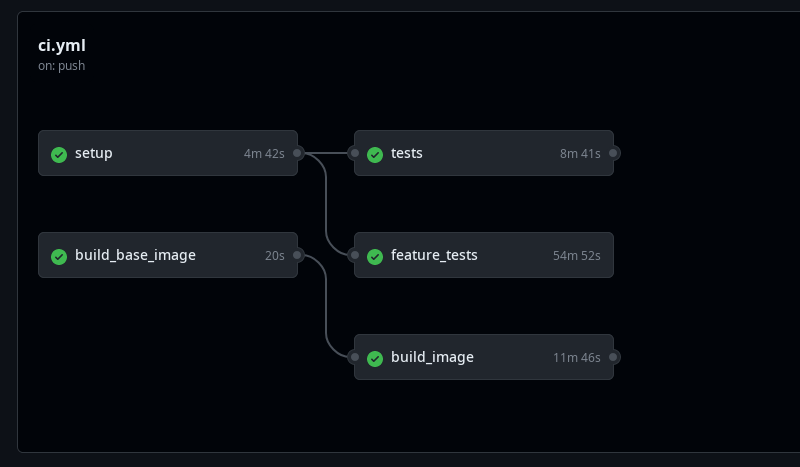Optimize Docker build image in GitHub Actions
Building docker images on every deployment can be time consuming but there are several ways to speed up the process.
The Setup
At my current job we have a CI/CD pipeline that builds a Docker image that is later deployed to replace the current version in production. It is a multi-step process (workflows, in GH parlance) that used to consist of:
- Run CI workflow (~50 minutes)
- Make sure application is installable (using cache to optimize dependencies downloads)
- Unit tests
- Integration tests (selenium)
- Run CD workflow (~30 minutes)
- Build image: some dependencies need to be compiled (~25 minutes)
- Deploy to production
The second workflow is run automatically by GH Actions when the first workflow
completes, i.e., on: workflow_run in the Workflow spec, so we would need to
wait for about 1 hour and a half before we actually see our changes in
production.
The Refactor

Since we use Docker for the build process, there’s already a tried and tested cache layer that I know we were not taking advantage of. After ducking around a bit, I arrived at Docker’s GitHub Actions cache documentation which outlines the (currently experimental) integration with Actions’ cache. To optimize image caching I decided to split the image into two:
- base: install system dependencies, e.g., runtimes and dependencies that need to be compiled and don’t change as often, e.g., HTTP server.
- application: install dependencies that can simply be downloaded or change more often.
After testing locally this reduced the build process from 20 to ~5 minutes, but when merged to the main branch and tested in the GH Actions servers, the cache didn’t work as expected.
This is because GH Actions cache was being created on the feature branch but, after merging, it would not be picked up by the main branch build process. There were multiple ways to solve this but I decided to restructure the pipeline to run some steps in parallel:
- Run CI workflow (~50 minutes): all steps in parallel
- Build image only for main branch
- Unit tests
- Integration tests
- Run CD workflow (~5 minutes)
- Deploy to production
With the new layout the CI process still takes a long time (due to selenium tests) but the whole pipeline runtime was reduced by about 30 minutes.
The above mentioned pipeline doesn’t illustrate that the “Build image” step is actually building both the base image and the application image which can be improved further by NOT building the base (i.e., go straight to cache) image unless specific files changed. In our case, we want to build the base image only if the base Dockerfile changes. To achieve this, I used the dorny/paths-filter action to detect changes on specific files, further reducing the processing needed to build the application image.
The Rails
This setup was conceived specifically for a Ruby on Rails application with
several gems that require a compilation with native extensions which is a
redundant step for dependencies like puma or sassc that rarely change.
So at the end of Dockerfile.base, after all “OS” dependencies have been
installed, we install these gems individually which will become CACHED
layers for the image build process, e.g.:
FROM --platform=linux/amd64 debian:12-slim AS geckox
RUN apt-get update -q && apt-get install -qqqqy ...
...
RUN gem install --no-document puma -v 6.4.0
RUN gem install --no-document sassc -v 2.4.0As a rule of thumb (which I break when my setup grows), I DO NOT include
ADD or COPY statements in my Dockerfile.base file to avoid unintentional
layer cache expiration; I add those to the Dockerfile.app image which usually
copies the application code to the image.
The CI Workflow
After all was said and done, the CI workflow looked something like this:
name: CI
on: push
jobs:
setup:
steps:
- Download dependencies...
tests:
steps:
- ...
integration_tests:
steps:
- ...
# Build docker images only for main
build_base_image:
if: ${{ github.ref == 'refs/heads/main' }}
env:
REGISTRY: ghcr.io
IMAGE_NAME: orgname/geckox/geckox-base-image
permissions:
contents: read
packages: write
steps:
- name: Checkout repository
uses: actions/checkout@v2
# dorny/paths-filter (git) errors out because of "dubious ownership in repository"
- name: "Change repository directory permissions"
run: |
git config --global --add safe.directory /data/runners/geckox/work/geckox/geckox || true
# https://github.com/dorny/paths-filter
- name: Check Dockerfile.base
id: changes_filter
uses: dorny/paths-filter@v2
with:
filters: |
dockerfile_base:
- added|modified: 'build/Dockerfile.base'
- name: Set up Docker Buildx
uses: docker/setup-buildx-action@v2
- name: Log in to the Container registry
uses: docker/login-action@v2
with:
registry: ${{ env.REGISTRY }}
username: ${{ github.actor }}
password: ${{ secrets.GITHUB_TOKEN }}
- name: Skip image build process for Dockerfile.base
if: steps.changes_filter.outputs.dockerfile_base == 'false'
run: echo "Skipping..."
# https://github.com/docker/build-push-action/tree/v4
- name: Build and push Docker image
if: steps.changes_filter.outputs.dockerfile_base == 'true'
uses: docker/build-push-action@v4
with:
context: .
push: true
cache-from: type=gha
cache-to: type=gha,mode=max
file: build/Dockerfile.base
tags: |
${{ env.REGISTRY }}/${{ env.IMAGE_NAME }}:latest
build_image:
needs: build_base_image
if: ${{ github.ref == 'refs/heads/main' }}
env:
REGISTRY: ghcr.io
IMAGE_NAME: orgname/geckox/geckox-app
GITHUB_SHA: ${{ github.sha }}
permissions:
contents: read
packages: write
steps:
- name: Checkout repository
uses: actions/checkout@v2
- name: Set up Docker Buildx
uses: docker/setup-buildx-action@v2
- name: Log in to the Container registry
uses: docker/login-action@v2
with:
registry: ${{ env.REGISTRY }}
username: ${{ github.actor }}
password: ${{ secrets.GITHUB_TOKEN }}
- name: Set IMAGE_TAG variable
run: |
echo "IMAGE_TAG=$GITHUB_SHA"
echo "IMAGE_TAG=$GITHUB_SHA" >> $GITHUB_ENV
# https://github.com/docker/build-push-action/tree/v4
- name: Build and push Docker image
uses: docker/build-push-action@v4
with:
context: .
push: true
cache-from: type=gha
cache-to: type=gha,mode=max
file: build/Dockerfile.app
build-args: |
BASE_TAG=latest
tags: |
${{ env.REGISTRY }}/${{ env.IMAGE_NAME }}:latest
${{ env.REGISTRY }}/${{ env.IMAGE_NAME }}:${{ env.IMAGE_TAG }}